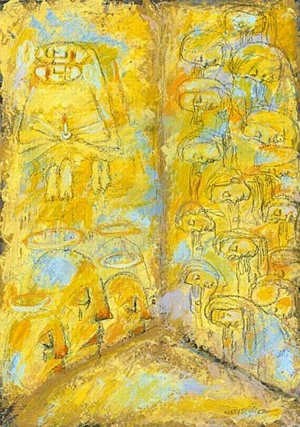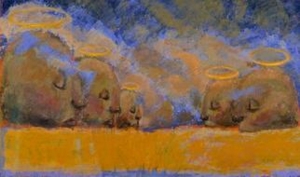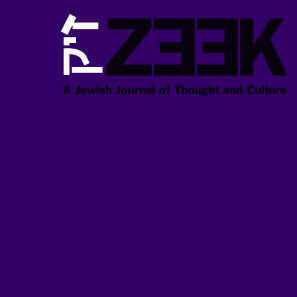 December 07
December 07
Against Mourning
by Anne Goldman
p. 2 of 3
 But the Holocaust resists capture. We might do better to expose Nazism to laughter than to continue addressing it as apotheosis of horror, a decision that affords this movement the dignified mantle of the epic. In his 2007 comedy My Fuehrer: The Truly Truest Truth about Adolf Hitler (filmed in Berlin with an all-German cast), Dani Levy wields satire as a weapon to cut Hitler and the Nazi movement down to size. But his parody also suggests we move beyond the ceaseless effort to “understand what we will never understand,” as the film ends by announcing. “[O]ne can today definitely affirm that the history of the Lagers has been written almost exclusively by those who, like myself, never fathomed them to the bottom,” Levi writes at the outset of The Drowned and the Saved. “Those who did so did not return, or their capacity for observation was paralyzed by suffering and incomprehension.” Though the bleakness of the camp approaches the certitude of what Levi calls “perfect unhappiness,” full understanding of experience eludes us. In spite of suffering, the human condition remains one of chronic semi-consciousness.
But the Holocaust resists capture. We might do better to expose Nazism to laughter than to continue addressing it as apotheosis of horror, a decision that affords this movement the dignified mantle of the epic. In his 2007 comedy My Fuehrer: The Truly Truest Truth about Adolf Hitler (filmed in Berlin with an all-German cast), Dani Levy wields satire as a weapon to cut Hitler and the Nazi movement down to size. But his parody also suggests we move beyond the ceaseless effort to “understand what we will never understand,” as the film ends by announcing. “[O]ne can today definitely affirm that the history of the Lagers has been written almost exclusively by those who, like myself, never fathomed them to the bottom,” Levi writes at the outset of The Drowned and the Saved. “Those who did so did not return, or their capacity for observation was paralyzed by suffering and incomprehension.” Though the bleakness of the camp approaches the certitude of what Levi calls “perfect unhappiness,” full understanding of experience eludes us. In spite of suffering, the human condition remains one of chronic semi-consciousness.
On a spring day several years ago I found myself regarding the ocean from the western vantage of San Francisco’s Palace of the Legion of Honor. The sky was windless, the water cerulean blue, the ridge of trees on the horizon etched fine as an engraving. Amidst this serenity, the tableau I stumbled across was grotesque. The plastered forms looked like burn victims wrapped in gauze or mummified relics from Pompeii. Frozen in postures of unrelieved awkwardness, they reproached my joy in the day’s soft brightness.
Most sculptures are designed to engage with the physical space that surrounds them. I picture Richard Serra’s massive ironworks hunkering underneath the vaulted ceiling of Bilbao’s Guggenheim, Michelangelo’s David gazing outward from Florence’s graceful Piazza della Signoria, the conquering eye of Lord Nelson surveying London from his column in Trafalgar Square. This memorial to the Holocaust spurned any such connection. George Segal’s deaf-and-dumb figures did not interrupt the loveliness of the landscape—they rendered it insignificant. And this ill placement was clearly the point, their lack of relief a metaphor for the discomfort we were meant to feel in the face of unremitting anguish.
Undoubtedly I will be accused here of callousness, called selfish, labeled an anti-Semite. Nonetheless, I find this emotional bludgeoning unacceptable. My own links with Europe are attenuated; my grandparents left Russia and Poland at the turn of the century, so I do not mourn the loss of any immediate family in the Holocaust. And I recognize the renewed urgency of testimonial as the last witnesses begin to pass away. Still, I am unwilling to continue participating in an endless ritual of “remembrance” that must, at least in my case, be false. Say what you will: to be goaded into gloom, chided like bad children until our faces assume the appropriate sepulchral cast, is neither to encourage empathy nor to prompt understanding.
When I lived in Israel many years ago I paid a visit to Yad Veshem. Today I can still picture the slender trees planted outside Jerusalem’s museum of remembrance. The flickering constancy of light and shadow through their leaves seemed to me then as eloquent a testament to the lost as any grander monument. I stumbled out of the hushed theater, but twenty minutes of footage was sufficient to understand its obscenity. I had been watching a newsreel of men push corpses down a Warsaw ghetto street. The limbs swung from side to side atop a piled wheelbarrow like any other load. The automatons driving them moved forward in silence, their faces altered and spiritless. Like the “non-men” Levi calls “Muselmänner” in the brutal tongue of the lager, these emaciated figures seemed like those in Survival in Auschwitz to “suffer and drag themselves along in an opaque intimate solitude.”
For Levi, the sight of faces upon which “not a trace of a thought is to be seen” encapsulates “all the evil of our time.” Why then are we so profligate in its reproduction? The camera’s ready-made intimacy invites conspiracy: to watch is to keep company with its persecuting gaze. I had stared at the Yad Veshem footage only to feel a partner in the men’s degradation. Now I conclude that it is not right—under any guise, even that of ethical obligation—to look upon the dead sprawled insensible of the camera’s eye, who, conscious of their capture by its lens, would have suffered a self-abnegating shame in addition to their physical humiliations. Begged to further the cause of historical documentation, how many of us would will our own bodies to such a display? To my mind our unceasing exposure to photograph, fiction, and testimonial raises more questions than it solves. Habituated to the language of apocalypse, we become facile with horror, marshalling up a familiar queasiness with each reminder of indecency.
Atlanta’s compact downtown is made expansive by a ring of skyscrapers that circle it like trees and between whose heights plenty of sky remain visible. The William Bremen Jewish Heritage Museum, which sits south of the city center and west of its graceful metropolitan avenues, is a low-slung building without a façade. Its austere geometry is typical of the generic modernism of much post-1960s architecture. Still, its severity jars in the context of these wide slow streets. The homes here are a century old. Lived in continuously rather than preserved as historic sites, they possess an easy elegance that tempers the walker’s envy of their privilege. To walk by them is to feel time stretched to a larger amplitude as the soft metronomes of veranda chairs rock in deliberate, regular rhythm.
Islanded by its modern architecture, the Bremen Museum is estranged from such equanimity. A smallish building, it boasts ample parking but few surrounding trees. From outside it seems not so much secretive as expressionless in the manner of federal buildings. Its blank front recalls Jewish tradition’s tendency to favor self-scrutiny over social negotiation, to make self-distinction rather than affiliation the object of examination. Too, in this place concerned with preserving the past, the proscription against graven images still carries a certain weight. Many Jews would recognize without being conscious of doing so that what might appear to be a closed quality—the building’s refusal to assimilate to the architecture of its surroundings—is not designed to cast aspersion on others but only to encourage the inward turn toward reverence. But it is not difficult to see how people unfamiliar with this way of locating the self in the world might translate distrust of decoration into dislike of their own society. When you cross the threshold and pull open its heavy windowless door, you feel as if you are leaving Atlanta far behind you. Perhaps a more ecumenical invitation would educate more visitors. I wonder what kind of gesture it would have been to design a structure consonant with the history of the city and its mix of cultures: how might this building look were it to insist upon Jewish rights of residency while acknowledging the Middle Passage along which the predecessors of some of the city’s black inhabitants suffered and died?
Although the Bremen is not in conversation with its locale, the museum speaks to sites for the preservation of Jewish culture elsewhere. Inside there is a very handsome lecture hall built to accommodate several hundred listeners and two wings of galleries. One door leads to a temporary display dedicated to the city’s Jewish residents, but the largest space is devoted to the museum’s permanent Holocaust exhibit. In here you wind through a series of small chambers connected by narrow hallways. The interior walls detail, in text and photograph, the history of modern German anti-Semitism that culminates in the Shoah. The exhibit’s design is predicated upon this unrelenting chronology. Its rooms are without alternative egress, sequential rather than adjacent, so you walk through them in the single direction the narrative permits. No doubt this lack options is designed to remind visitors of the constricted, ever-narrowing aperture Europe became for Jews during World War II. Coupled with the building’s low ceilings, dim lighting and grim portraiture, the inviolate chronology provokes hopelessness and claustrophobia in equal measure.
Its spatial determinism also mirrors the institution’s temporal rationale. Like other museums of remembrance, the Bremen presents history as inexorably linear. Its chronology plays out backwards from the apocalyptic moment of the Shoah, which, as origin point, becomes curiously ahistorical. Such retroactive dating provides the frame within which, as Michael André Bernstein argued in Foregone Conclusions (1994), the “entire experience” of European Jewry “prior to the Third Reich is judged.” My sense is that the Bremen, in situating the Holocaust as the anticipated outcome of a course carried through to completion, wishes to accord the mass extermination of Europe’s Jews coherence and dignity. Certainly the funerary rhythm of its procession of events lends the whole a tragic grandeur. Unfortunately, this tidy progression also echoes the quasi “logical” rhetoric of the Final Solution itself.
As in similar institutions across the country, the exhibit is a dirge; its ritual of “remembering” keeping us trained upon the end we have anticipated from the first room’s display of photographs. Paradoxically, the urgency of its timescale encourages a suspension of faculties rather than a quickening of them. You walk through the rooms, look intently at the photographs and read the scripts, only to be overtaken by inertia potent as incipient nightmare. The air feels torpid, a vacuum simulating the silence of the Shoah. You look again at the faces of the dead, but they have been effaced by the devastation of History writ large. This epic sweep blots out the quotidian life the museum is dedicated to preserving—the excited mix of Yiddish, French, and Polish you might have overheard at a Warsaw dinner table, the sweet butter linzertorte you could have tasted in a Berlin bakery. What gets lost may seem slight, but it is the kind of detail that allows us to linger upon the particulars of distinct lives: the plaid skirt a daughter wore in her last photograph, the scuffed suitcase a father filled with the family’s prized possessions, the book upon whose flyleaf the date of a bar-mitzvah, penned in spidery script, speaks of inspiration and of blessing.
 There is little equivalence between public forms of mourning and the private expression of grief. Deep feeling—for a person, a place, or a past—is oblique and hallucinatory, its words spoken sotto voce, its presence a ghost shadowing us on our daily routines. Collective mourning proclaims what it misses, hoping volume and magnitude compensate for absence. In monumental architecture, the permanence of granite and steel is a protest against the fragility of memory. The garden of New York’s Museum of Jewish Heritage is filled with tons of stone, the polished surface of the Vietnam Memorial engraved with thousands of names. For a time, the space once occupied by the Twin Towers was illumined with a million kilowatts of electricity. Its radiant blue beauty climbed skyward with more than a hint of that power’s threat.
There is little equivalence between public forms of mourning and the private expression of grief. Deep feeling—for a person, a place, or a past—is oblique and hallucinatory, its words spoken sotto voce, its presence a ghost shadowing us on our daily routines. Collective mourning proclaims what it misses, hoping volume and magnitude compensate for absence. In monumental architecture, the permanence of granite and steel is a protest against the fragility of memory. The garden of New York’s Museum of Jewish Heritage is filled with tons of stone, the polished surface of the Vietnam Memorial engraved with thousands of names. For a time, the space once occupied by the Twin Towers was illumined with a million kilowatts of electricity. Its radiant blue beauty climbed skyward with more than a hint of that power’s threat.
The largesse of public mourning reminds us of the breadth of loss, but it also exempts us from attention to detail. Enormity of scale possesses its own momentum. I learned this on a visit to the Hoover Dam in Arizona years ago. The fluted granite walls of this funnel rise to a curved rim hundreds of feet above the river floor. From far away the dam’s parabola is companion to the sky’s weightlessness. But lean over the rim, and the steep slope drags you downward. Falling from the dam is the same as stepping off a skyscraper fifty-five stories high. One glance at the seven hundred foot drop and vertigo seizes you: the convex stone pulls away, its dizzying curvature carrying sensation with it. The sounds of traffic and the shrieks of children, the shimmer of heat on the freeway and the rough cement under your hands: all vanish in this freefall.
To stand in the shadow of a memorial is to experience a similar loss of perspective, and with it, the small certainties of your own footing. The size of most monuments accords them the same visual draw as the dam’s steeply inclined sides. How easy it is to pay our respects to these massive tombs and in doing so lose sight of the lives they betoken. “Awe” and “awful”: the syntax of destruction and beauty twine, uncomfortably close. Voyeurs, we enjoy an aesthetic response to a problem that demands a moral focus. The opiate of feeling binds us together superficially but dissipates as quickly, depriving us of mindfulness. Nor does the splendor of these obelisks permit the peripheral vision of memory, more insight than spectacle.










